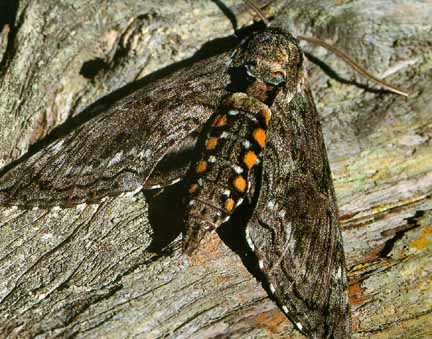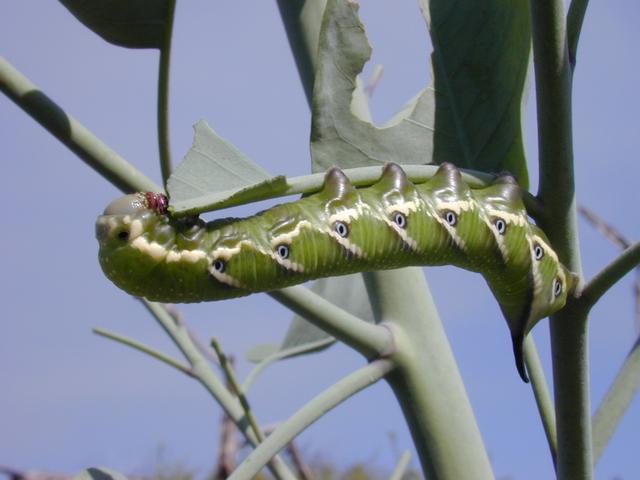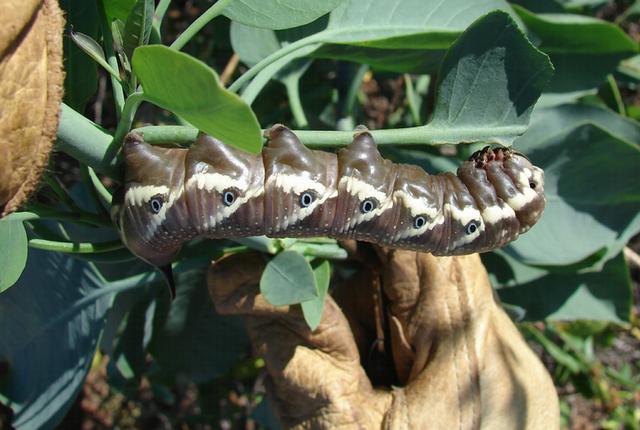Manduca blackburni
Updated as per personal communication with Daniel Rubinoff, September 17, 2015 as per
Proceedings of the Hawaiian Entomological Society: "Life History and Host Range of Hawaii’s Endangered
Blackburn’s Sphinx Moth (Manduca blackburni Butler)"; Daniel Rubinoff and Michael San Jose.
Manduca blackburni
Blackburn's Sphinx Moth
(Butler, 1880)

Manduca blackburni courtesy of W. P. Mull.
This site has been created by
Bill Oehlke at oehlkew@islandtelecom.com
Comments, suggestions and/or additional information are welcomed by Bill.
TAXONOMY:
Family: Sphingidae, Latreille, 1802
Subfamily: Sphinginae, Latreille, [1802]
Tribe: Sphingini, Latreille, 1802
Genus: Manduca Hubner, [1807] ...........
Species: blackburni (Butler, 1880)
|
MIDI MUSIC
.....It's a Wonderful World.....
copyright C. Odenkirk
ON.OFF
<bgsound src="world.mid" LOOP=FOREVER>
|
DISTRIBUTION:
Blackburn's Sphinx Moth, Manduca blackburni,
flies in Hawaii.
Previously known from all the main islands, this rare endemic Hawaiian sphinx moth is now known only from Maui.
Update to this page: According to Rubinoff and San Jose, 2010, this species is "now restricted to small localized populations on the islands of
Maui, Hawaii, and Kahoolawe." "It is extinct on the islands of Kauai, Oahu, Lanai and Molokai."
It is normally found in coastal and dry forests. It is a close relative of the tomato horn worm of North America. It is the
first Hawaiian insect to be proposed as endangered.
FLIGHT TIMES:
Manduca blackburni adults fly in January, April, October and December and possibly/probably in other months.
ECLOSION:
Pupae probably wiggle to surface from subterranean chambers just prior to eclosion. Rubinoff and San Jose report pupation
at bottom of pots with 15cm of soil. The larvae did not burrow as deep if they were pupating under a supporting structure such as plant roots.
SCENTING AND MATING:
Females call in the males with a pheromone released from a gland at the tip of the abdomen. Adults take nectar from flowers.
EGGS, LARVAE, PUPAE:
Larvae have been reported on Lycopersicon, Nicotiana, Nicotiana glauca, Nothocestrum latifolium (an endangered, native host)
and Solanum melongena. Rubinoff and San Jose add Solanum americanum and Solanum sandwicense.
Rubinoff report that Solanum americanum and Solanum sandwicense (an Hawaiian endemic) have been successfully used as hostplants in the lab, and that
eggs in the wild have been found on Nicotiana glauca. There are also reports of larvae feeding on tomato (Lycopersicon esculentum).
Larval development is quite rapid in lab rearing programs with larvae passing through the first four instars in as few as fourteen days,
so three to four days are spent in each early instar. As many as six to nine days are spent in the final instar with moths often emerging within six weeks of pupation.
Rubinoff and San Jose provide desciptions and images of eggs and most instars in their 2010 publication. They also indicate that the dark larval form (purple)
can be found feeding sympatric with the green form. I believe the identifications below are correct, so there also appears to be what I would call a brown form.
Probably the different forms can be siblings.

Manduca blackburni green form, Puu o Kali, Maui, Hawaii,
November 23, 2002, courtesy of Forest & Kim Starr.

Manduca blackburni brown form, Kanaha Beach, Maui, Hawaii,
December 14, 2006, courtesy of Forest & Kim Starr.
Return to Sphingidae Index
Return to Sphingini Tribe
Previously known from all the main islands, this rare endemic Hawaiian sphinx moth is now known only from Maui. (as of 2010 also on Hawaii and
Kahoolawe
(Photos: Betsy Gagne) green and dark forms. Development from egg to adult can take as little as 56 days, but pupae may aestivate
(dormancy during a period when conditions are hot and dry) in the soil for
as long as a year. Adult moths can be found year round but seem to be most active during two periods, January to April and September to November. Adult moths are
strong fliers.
Once found on six Hawaiian islands, the moth now exists only on Maui, Kaho`olawe, and the island of Hawai`i. They were believed extinct
until 1984 when a small population was rediscovered in a lowland dry forest on the south coast of East Maui (Kanaio area). Additional
small isolated populations are now known from other parts of Maui.
Populations were recently discovered on Kaho`olawe (the first record of this species on this island) in 1997 and in 1998 in North Kona on the island of Hawaii.
Threats to Blackburn’s Sphinx Moth include introduced ants and parasitic wasps that prey on the eggs and caterpillars, and the loss
of its native host plant, `aiea, which is a dryland forest tree.
Eric Hossler writes, December 2011: Manduca blackburni - fully mature larvae very commonly observed on Nicotiana glauca, on Maui,
along Mokulele highway, March 2011. Damage to the plant was pretty easily spotted, and larvae were right on the tips of the branches. I also saw one ova in
October 2010, and leaf damage, but both of these could have been old.


